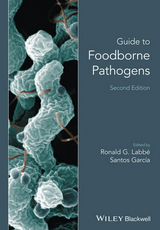
Guide to Foodborne Pathogens
John Wiley & Sons Inc (Verlag)
978-0-471-35034-7 (ISBN)
- Titel erscheint in neuer Auflage
- Artikel merken
This volume of Guide to Foodborne Pathogens offers broad and accessible coverage of the pathogens--bacteria, viruses, and parasites--most commonly responsible for foodborne illness. It discusses the nature of illnesses; the epidemiology of pathogens; and current detection, prevention, and control methods. It also features chapters on the globalization of the food supply, seafood toxins, and other miscellaneous agents. Twenty-one chapters, by experts from around the world, cover the most dangerous illnesses and foodborne pathogens currently threatening world populations. Topics include: -Arcobacter/Helicobacter -Aspergillus -Bacillus cereus -Campylobacter -Clostidium perfringens -Clostridium botulinum -Escherichia coli -Fusarium -Listeria -Salmonella -Shigella -Staphylococcus aureus -Vibrio -Yersinia enterocolitica Guide to Foodborne Pathogens offers up-to-date analysis of the growing body of scientific information on both established and new and emerging pathogens. It provides concise coverage that serves the needs of scientists and food professionals who lack a specialized background in foodborne illness but want to stay informed on this vital health issue.
RONALD G. LABBE is Professor of Food Microbiology in the Department of Food Science at the University of Massachusetts in Amherst. SANTOS GARCIA is Professor of Microbiology in the Department of Microbiology and Immunology at the University of Nuevo Leon in Monterrey, Mexico.
Preface; Contributors; 1. Epidemiology and Globalization of Foodborne Disease (Ewen C. D. Todd); 1.1. Introduction; 1.2. Surveillance of Foodborne Disease; 1.3. Meat and Poultry; 1.4. Fish and Shellfish; 1.5. Eggs and Dairy Products; 1.6. Vegetables and Fruits; 1.7. Environment; 1.8. Surveys of the Public on Knowledge of Foodborne Diseases and Its Prevention; 1.9. High-Risk Populations; 1.10. Policies to Reduce Foodborne Disease; 1.11. Conclusion; Bibliography; 2. Arcobacter and Helicobacter (Irene V. Wesley); 2.1. Arcobacter; 2.2. Helicobacter; Bibliography; 3. Aspergillus (Deepak Bhatnagar and Santos Garcma; 3.1. Introduction; 3.2. Ecology of Aspergillus; 3.3. Isolation of Aspergillus; 3.4. Identification of Aspergillus Species; 3.5. Detection of Mycotoxins; 3.6. Nature of Illness; 3.7. Prevention and Control; References; Bibliography; 4. Bacillus cereus (R. W. Bennett); 4.1. Introduction; 4.2. Nature of Illness; 4.3. Characteristics of Agent; 4.4. Epidemiology; 4.5. Detection of Organism and Toxins; 4.6. Physical Methods for Destruction; 4.7. Prevention and Control; References; Bibliography; 5. Campylobacter (Norman J. Stern); 5.1. Introduction; 5.2. Nature of Disease; 5.3. Characteristics of Agent; 5.4. Epidemiology; 5.5. Detection of Organism; 5.6. Prevention and Control; Bibliography; 6. Clostridium botulinum (Barbara M. Lund and Michael W. Peck); 6.1. Introduction; 6.2. Botulism; 6.3. Properties of C. botulinum and Botulinum Neurotoxins; 6.4. Epidemiology; 6.5. Detection and Isolation; 6.6. Prevention and Control; 6.7. Conclusion; Bibliography; 7. Fusarium (Lloyd B. Bullerman); 7.1. Introduction; 7.2. Nature of Illness in Animals and Humans; 7.3. Characteristics of Fusarium Toxins; 7.4. Detection, Isolation, and Identification; 7.5. Occurrence and Stability of Toxins in Foods; 7.6. Prevention and Control; References; Bibliography; 8. Listeria monocytogenes (Catherine W. Donnelly); 8.1. Introduction; 8.2. Listeriosis in Humans; 8.3. Pathogenesis; 8.4. Foodborne Transmission; 8.5. Sources of Listeria and Food-Processing Environments; 8.6. Detection of Listeria in Foods; 8.7. Conclusion; References; 9. Clostridium perfringens (Norma L. Heredia and Ronald G. Labbi); 9.1. Introduction; 9.2. Nature of Illness in Animals and Humans; 9.3. Characteristics of Agent; 9.4. Epidemiology; 9.5. Detection of Organism; 9.6. Physical Methods for Destruction; 9.7. Prevention and Control; Bibliography; 10. Escherichia coli (Peter Feng); 10.1. Introduction; 10.2. Nature of Illness and Epidemiology; 10.3. Detection of Organism and Pathogenticity Testing; 10.4. Physical Methods for Destruction; 10.5. Prevention and Control; References; Bibliography; 11. Salmonella (Jean-Yves D'Aoust); 11.1. Introduction; 11.2. Nature of Illness; 11.3. Characteristics of Salmonella spp; 11.4. Epidemiology; 11.5. Detection; 11.6. Physical Methods for Destruction; 11.7. Prevention and Control; References; 12. Shigella (David W. K. Acheson); 12.1. Introduction; 12.2...
| Erscheint lt. Verlag | 12.10.2001 |
|---|---|
| Zusatzinfo | Ill. |
| Verlagsort | New York |
| Sprache | englisch |
| Maße | 164 x 240 mm |
| Gewicht | 730 g |
| Einbandart | gebunden |
| Themenwelt | Studium ► 2. Studienabschnitt (Klinik) ► Pharmakologie / Toxikologie |
| Naturwissenschaften ► Biologie ► Botanik | |
| Technik ► Lebensmitteltechnologie | |
| Weitere Fachgebiete ► Land- / Forstwirtschaft / Fischerei | |
| ISBN-10 | 0-471-35034-6 / 0471350346 |
| ISBN-13 | 978-0-471-35034-7 / 9780471350347 |
| Zustand | Neuware |
| Informationen gemäß Produktsicherheitsverordnung (GPSR) | |
| Haben Sie eine Frage zum Produkt? |
aus dem Bereich



